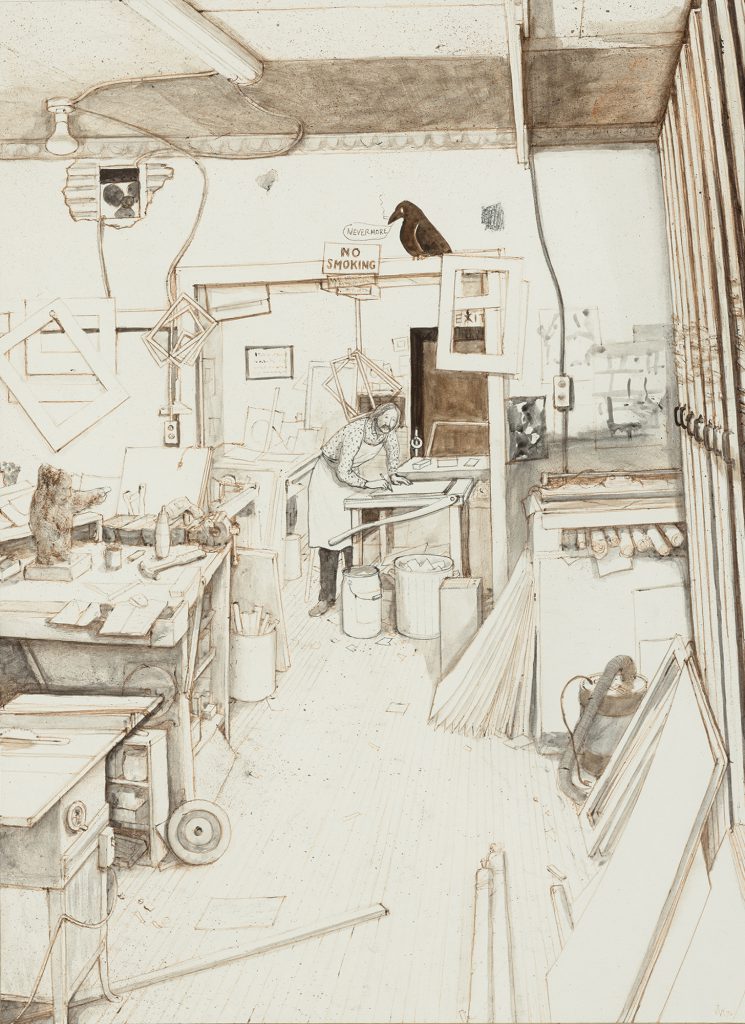
Estimated: $30,000-40,000
Spring Live Auction of Important Canadian Art (June 15th)
William Kurelek was one of Canada’s most idiosyncratic artists of the twentieth century. His work remains both critically acclaimed and popular, although Kurelek resisted ideas of artistic exceptionalism and genius. “The Isaacs Gallery Workshop” is a 1973 ink drawing, once owned by gallerist Avrom Isaacs, that is now in the permanent collection of The Art Gallery of Ontario. In 1976 Kurelek completed “Brian in the Old Workshop”, a cropped version of the Art Gallery of Ontario drawing. It focuses solely on Dedora, bent over cutting glass.Kurelek gifted this drawing to Brian Dedora in 1976 and now Cowley Abbott is honoured to be entrusted with this personal and enlightening artwork.
Take a moment to watch this video narrated by Rob about Kurelek and this personal artwork, “Brian in the Old Workshop”.
Interview with Brian Dedora
In April 2022 Brian Dedora spoke with Andrew Kear about his relationship to William Kurelek, his time at the Isaacs Gallery Workshop, and the drawing “Brian in the Old Workshop”.
AK: You started working at the Isaacs Gallery workshop in 1970. When did you first meet William Kurelek?
BD: I was in Toronto. There was a little gallery on Young Street called the Gutenberg Gallery. And I heard from a Carl Gutenberg, the guy who owned the place, that there was an opening in the framing department at Isaacs. And so, on a Saturday after a beer—I needed some courage—I wandered up to meet Av Isaacs. I said, “I heard that you need a fitter. I am a fitter, and I’m really fast and good.” And he said, “Great, report to the shop Monday morning at nine o’clock.” I was a bit trepidatious, to tell you the truth. You know, being unemployed and feeling a little vulnerable. But when I walked into that shop, within four or five steps into that space, I knew that this was a real live workshop. You could smell it. It was, you know, the lacquers and the shellacs and the gesso and all of it. And then later in the day, Bill [Kurelek] walked in. I didn’t know who he was, actually. He walked down and wanted to know if I was Ukrainian. And I said, “Well, as a matter of fact, my dad is Ukrainian.”
AK: Could you explain what a fitter does, in the context of a framing workshop?
BD: The shop had three distinct spaces, and they were called “ends”— because [workshop foreman] Stan Beecham was British, and this is what they call workshop rooms. So, the first thing you’d walk into was the finishing end. Then you’d walk into a larger room, which was the cutting and joining end. And then the fitting end, where you’d assemble the mats, the glass, the frame and fit it all to the artwork, wrap it all up, put paper on the back with eye screws and wire so that it’s ready to go. I arrived at Isaacs in 1970, just at the Christmas into 1971. So, I was there really from, you know, late-1970 to 1976.
AK: Was Kurelek around the workshop over those six years, between 1970 and 1976?
BD: Yes. He continued to have his own space in the finishing end, and his own bench. That bench is where he, you know, assembled his frames for his paintings. Bill made his end in the shop his own. Every now and then, he’d make up a huge batch of gesso and would paint his benches, drawers, and everything in brilliant white, until it got worn down.
AK: In 1970, what was workshop culture like?
BD: The shop was a place of camaraderie, for and with Bill. And it was a place where he could, you know, meet other men, talk, and stuff like that. But he was pretty straight. The fitter prior to me had hung up some nudies in his end, and Bill came down with a black brush and painted them out. Not their faces, but everything else. We were all essentially run by Stan Beecham, who had an amazing ability to make the workshop flow. Bill often worked at night. There was a little bone of contention between him and Stan because Bill would bring in the barnboards he used for his frames, and there’d be the odd nail that would dull the saw blade. So, Bill decided to bring his own saw blades. It was always pretty magical and warming to come, you know, to the shop on winter days, walking in from the Annex, and see the light on and know that Bill was there. And you’d walk into that lovely warm space, smelling of glue and shellac, and all of it. And there would be Bill, working. And it was our little time to talk. When I graduated from fitting to finishing, I was suddenly working in the same space as Bill. And he was a fantastic teacher.
AK: That is my next question. What did Kurelek teach you, especially in the finishing end?
BD: Well, we had already talked about our rather authoritative Ukrainian fathers. The previous finisher had left, and so I just jumped in the deep end and took over. I knew some basics and stuff, but the finisher prior to me gave me the wrong formulas—so that I couldn’t be as good as him, right? That was what it was like in the old times. Anyway, there was a frame I was finishing, and I couldn’t get the gold leaf into a beading line—the place where two shapes join in a frame. I said, “Bill, I don’t know how to do this.” He came over—he was so quiet, so generous—and he showed me how to bring the gold leaf slowly across so you can bury it into that deep line and then draw it away to do the next part of the frame. It’s a technique I’ve used all my framing life. But he was wonderful. He was very sensitive to somebody deriding you because of your ignorance.
AK: What were your impressions of the frames Kurelek made for his own work?
BD: Bill understood classical framing intimately because of his work in London. And he was able to make little innovations on that. I love his barnboard stuff. In the basement of the shop, he had a whole load of barnboard that he had scavenged from God knows where. Kurelek would paint on his gesso, let it dry. He would rub it down with cold wet linen. And that was the only smoothing that took place. He did not use sandpaper to take out the flaws. And so, when he gilded it, it was a much more organic feeling than the very precise French tradition. Bill’s work was very organic, very rounded. The odd flaw in the gold—they call it a “holiday”—was allowed to stay. And it worked because he knew how to blend the whole thing together.
AK: What is it about Brian in the Old Workshop that resonates with you?
BD: Oh, well it is the spirit of that place. I mean, there’s all sorts of detail, and the place was so full of detail, really. There’s a weight in the picture if you notice—like, for lifting. Well, that’s what we used to weigh things down with in the shop. That’s me in the background there, you know, smashing glass. But there’s so many references, like the little Inuit sculpture on Stan’s bench, pointing at us. But also, the machinery. There’s the press, and then you’re looking into the fitting room. I love that “Nevermore” from Poe’s raven—because it was literally the shop’s fitting end. Right? Bill loved puns. We looked onto the alley, just off Yorkville. And, at that time, it was an older Toronto, so the back lane was old swayback fences and hollyhocks growing there, and the sunlight coming in would hit your workspace in a particular way. And it was warm and toasty in there because we were always heating up something. The shop was much more medieval than what a shop would be today, with nail guns and mat cutters. We were doing everything by hand. It was all by hand. And so, it was a completely different framing world than what you would see if you walked into a shop today.
Join us on June 15th at 7 pm when this William Kurelek drawing will be offered in our major spring auction.

